Welcome to the final installment of “India’s Economic Odyssey: Past to Present.” As we navigate through the 21st century, India stands on the brink of a new era, marked by rapid economic growth, technological innovation, and an increasingly prominent role on the global stage. Yet, this journey is not without its challenges. Today, we explore the multifaceted landscape of contemporary India, examining the strides made and the hurdles that lie ahead.
Economic Growth and Integration
In the 21st century, India’s economy has witnessed remarkable growth, making it one of the world’s fastest-growing major economies. This period of rapid expansion can be traced back to the economic liberalization initiatives of the 1990s, which opened up the Indian market to global investors and dismantled many barriers to trade and investment. As a result, foreign direct investment (FDI) flowed into various sectors, fueling growth and modernization.
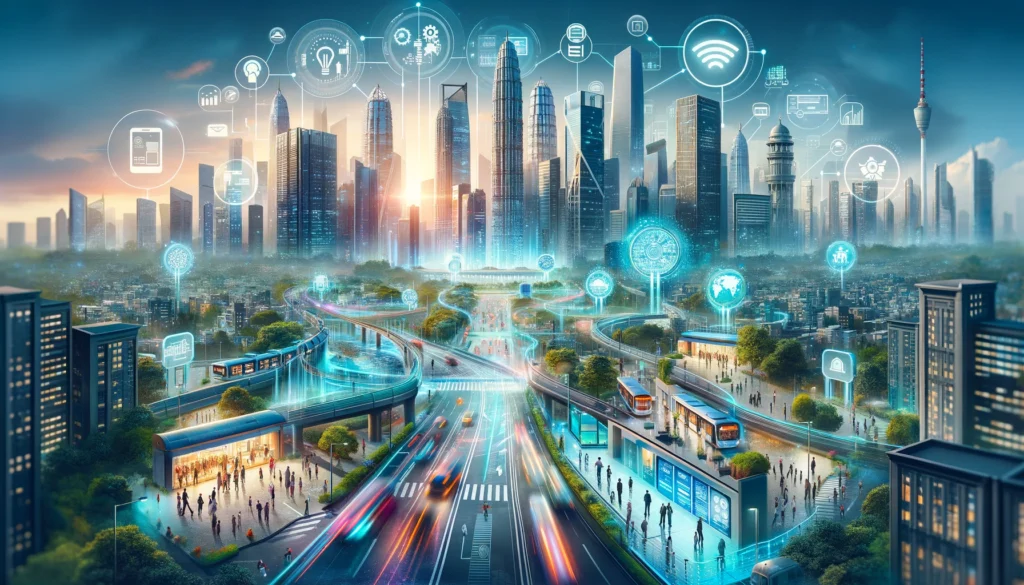
India’s integration into the global economy has been a key driver of this growth. The country has become an important player in the global market, with its exports diversifying from traditional goods such as textiles and handicrafts to software, pharmaceuticals, and automotive products. This diversification has not only increased India’s foreign exchange reserves but has also enhanced its standing in international trade negotiations and economic forums.
The government has played a crucial role in facilitating this growth through strategic policy interventions aimed at improving the business environment. Initiatives like “Make in India” have been designed to transform India into a global manufacturing hub, attracting investment from multinational corporations and boosting domestic production.
Moreover, trade agreements and partnerships have been pursued to further integrate India with global economies, ensuring that the country remains a key destination for trade and investment in the decades to come.
Technological Advancements and the Digital Revolution
The turn of the century also marked the beginning of a technological revolution in India, with the information technology (IT) sector leading the charge. India’s success in IT and software services, characterized by its export-driven model, has positioned the country as a global IT powerhouse. This boom in the IT sector has not only contributed significantly to India’s GDP but has also created millions of jobs, fostering a culture of innovation and entrepreneurship.

Building on this foundation, the Indian government launched the Digital India initiative, aiming to transform the entire ecosystem of public services through the use of information technology.
The initiative seeks to provide digital infrastructure as a utility to every citizen, governance, and services on demand, and digital empowerment of citizens. From digital payment platforms to e-governance services, Digital India has been pivotal in making technology accessible to millions, thereby improving the quality of life and creating new economic opportunities.
The digital revolution has also spurred innovation in various sectors such as fintech, e-commerce, and edtech, facilitating the emergence of startups that are solving complex challenges and catering to the needs of a vast and diverse population. The proliferation of smartphones and the internet has further democratized access to information and services, making India one of the largest and fastest-growing digital markets globally.
As India continues to navigate its 21st-century journey, the interplay between economic growth, technological advancements, and digital revolution remains central to its narrative. These developments not only underscore India’s resilience and adaptability but also highlight the potential challenges and opportunities that lie ahead in achieving sustainable and inclusive growth.
Social and Demographic Changes
India’s socio-economic landscape is undergoing rapid transformation, driven by significant social and demographic changes. The country boasts one of the world’s largest and youngest populations, presenting both a remarkable opportunity and a formidable challenge. The “demographic dividend” offers India a potential boost in economic growth, provided these young individuals are adequately skilled and employed.
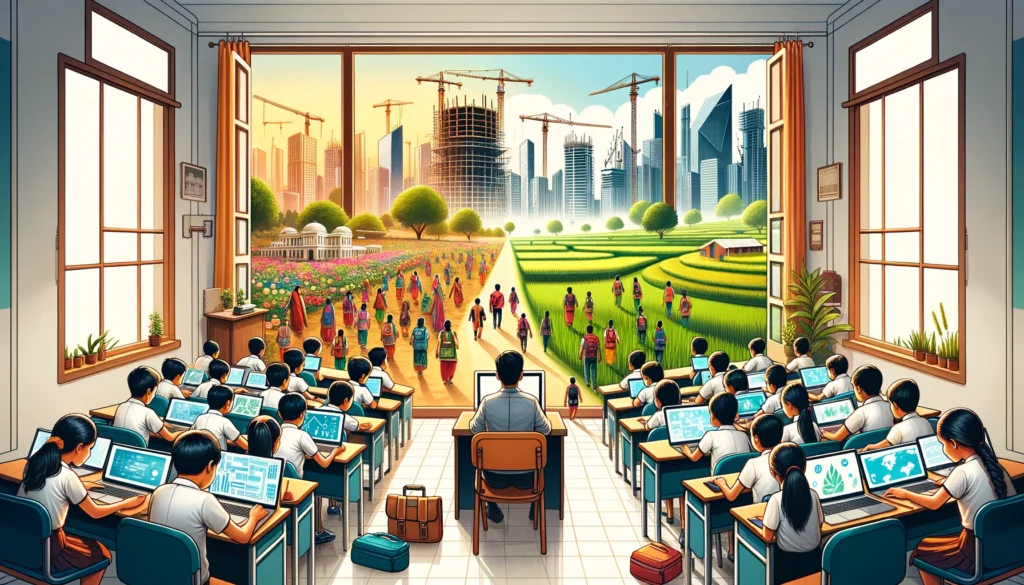
Urbanization is another critical aspect of India’s demographic shift, with millions moving to cities in search of better opportunities, thereby fueling economic development but also creating challenges in urban planning, infrastructure, and services.
Education and skill development are at the forefront of harnessing the demographic dividend. The government and various NGOs are implementing programs to improve access to quality education and vocational training, aiming to prepare India’s youth for the jobs of tomorrow.
However, achieving inclusive growth requires addressing disparities in education and employment opportunities, particularly for women and marginalized communities, ensuring everyone can contribute to and benefit from India’s economic progress.
Environmental Sustainability and Challenges
As India strides towards economic growth, the imperative of environmental sustainability cannot be overstated. The country faces pressing environmental challenges, including air and water pollution, deforestation, and climate change, which threaten to undermine its progress.
Recognizing these challenges, India is taking significant steps towards sustainable development. Initiatives like the National Solar Mission and the commitment to increase renewable energy capacity are testaments to India’s efforts to transition to a low-carbon economy.
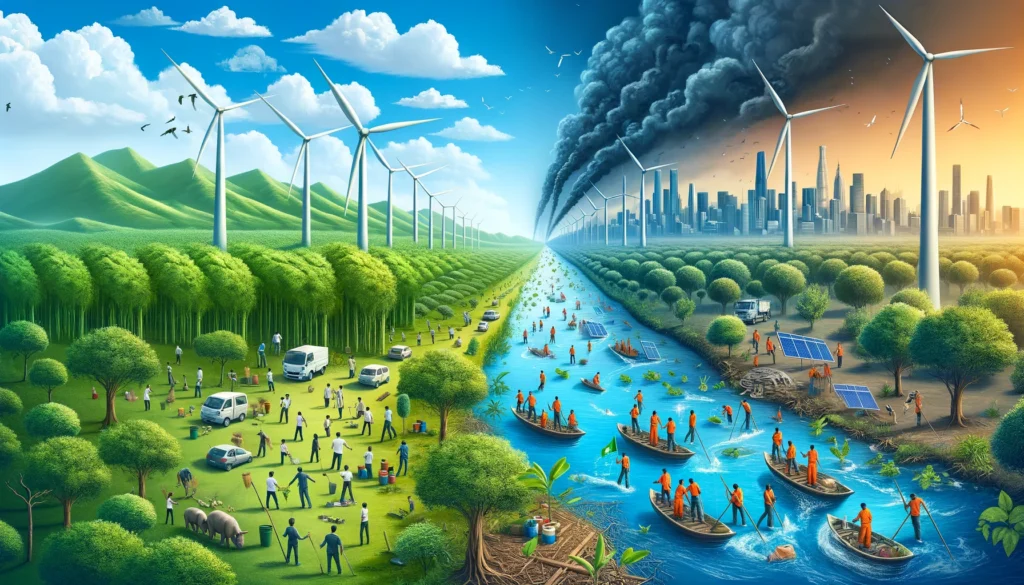
However, balancing rapid economic development with environmental sustainability is a complex challenge. Policies focusing on sustainable urban planning, waste management, and conservation of natural resources are critical.
India’s participation in international climate agreements underscores its commitment to global environmental governance, but the path forward requires concerted efforts from the government, private sector, and civil society to embed sustainability into the heart of India’s growth story.
Author’s Note
As we wrap up our exploration into India’s economic journey through the 21st century, it’s evident that the nation is at a pivotal crossroads. The opportunities presented by its demographic dividend, technological advancements, and economic reforms are immense.
Yet, the challenges of social inequality, environmental sustainability, and ensuring inclusive growth are equally significant. India’s path forward is one of balancing growth with equity, innovation with tradition, and ambition with sustainability. The journey of “India’s Economic Odyssey: Past to Present” is a narrative of resilience, transformation, and hope.
As we look to the future, the lessons from India’s past and its strides in the present offer valuable insights for navigating the complexities of a rapidly changing world. Thank you for joining us on this journey, and we hope it has provided a deeper understanding of India’s dynamic economy and the broader implications for global economic trends.
G.C., Ecosociosphere contributor.
References and Further Reading
- “India 2020: A Vision for the New Millennium” by A.P.J. Abdul Kalam and Y.S. Rajan offers insights into India’s potential for economic and technological development.
- “India Unlimited: Reclaiming the Lost Glory” by Arvind Panagariya provides an analysis of India’s economic reforms and growth trajectory.
Stay tuned for more insightful explorations into the economies and markets shaping our world today. Thank you for joining us on this journey through India’s economic history and contemporary challenges.

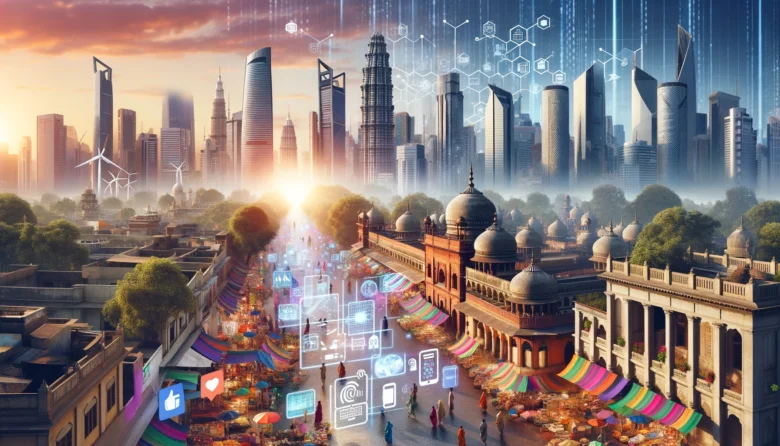
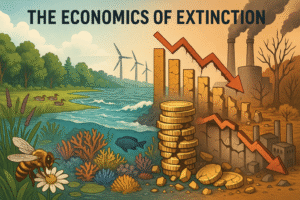


Comments
Your article helped me a lot, is there any more related content? Thanks!